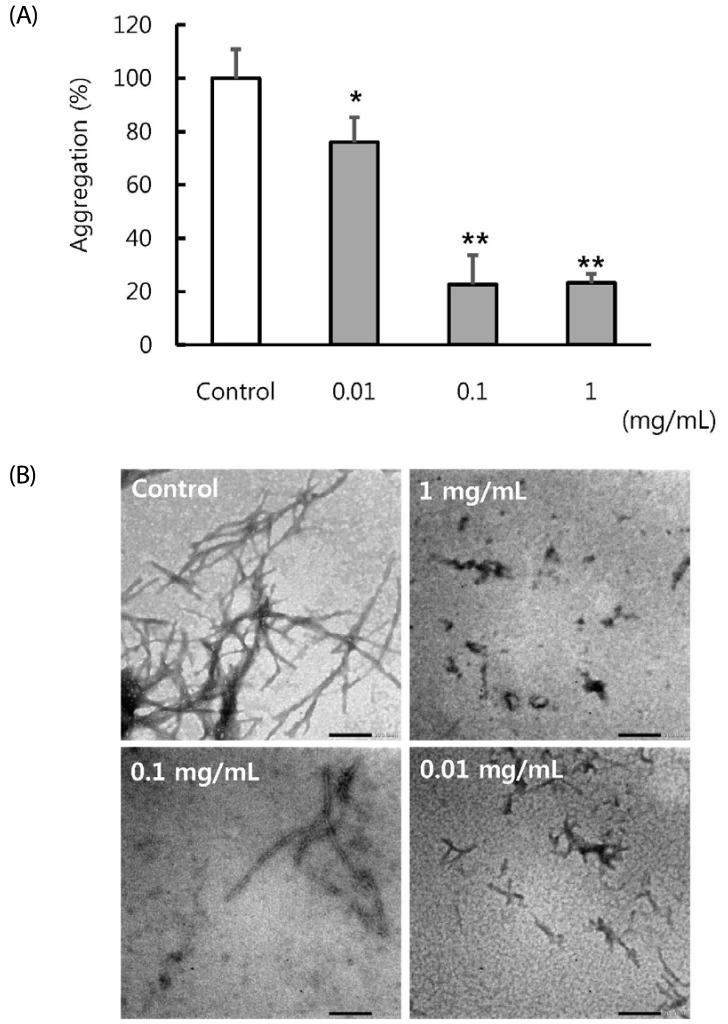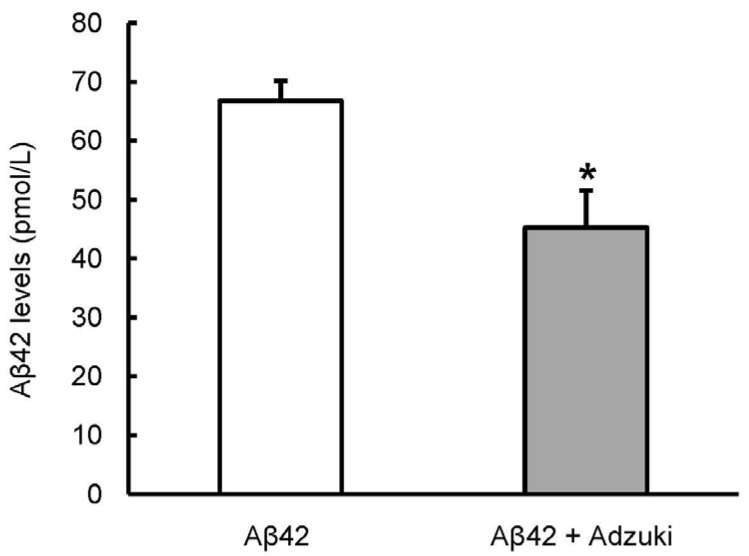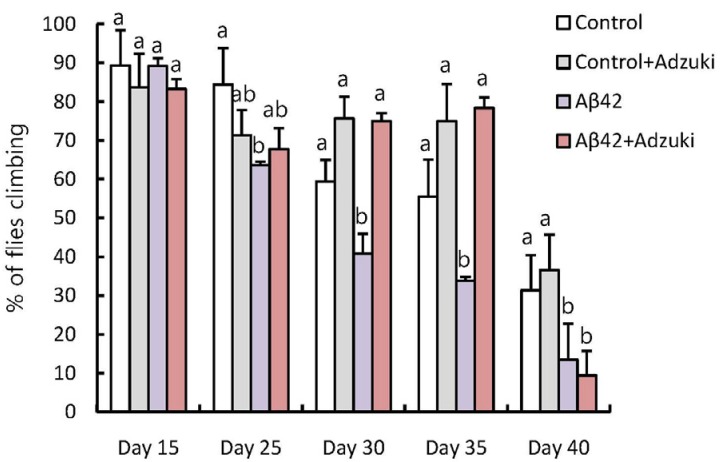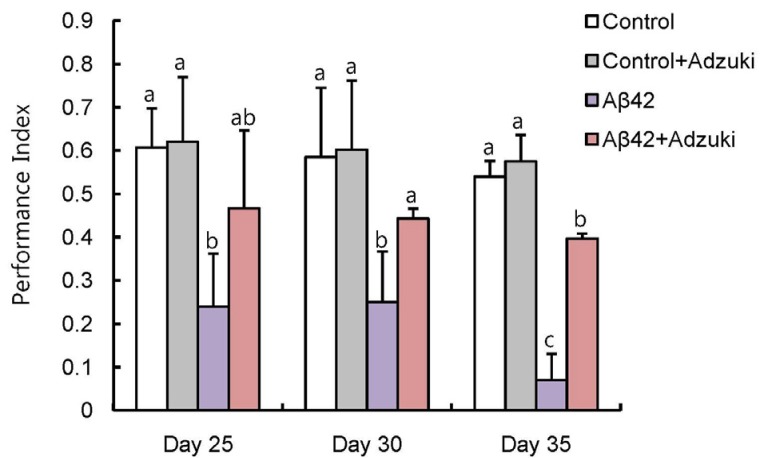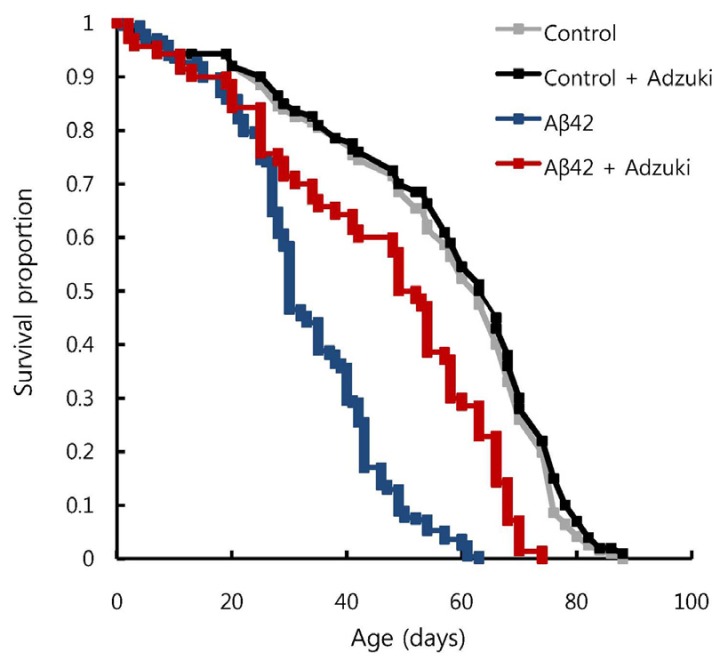Nutr Res Pract.
2019 Feb;13(1):64-69. 10.4162/nrp.2019.13.1.64.
Adzuki bean (Vigna angularis) extract reduces amyloid-β aggregation and delays cognitive impairment in Drosophila models of Alzheimer's disease
- Affiliations
-
- 1Interdisciplinary Graduate School of Science and Technology, Shinshu University, 8304 Minamiminowa, Kamiina, Nagano 399-4598, Japan. yonekura@shinshu-u.ac.jp
- 2Department of Interdisciplinary Genome Sciences and Cell Metabolism, Institute for Biomedical Sciences, Interdisciplinary Cluster for Cutting Edge Research, Shinshu University, 8304 Minamiminowa, Kamiina, Nagano 399-4598, Japan.
- 3Graduate School of Science and Technology, Shinshu University, 8304 Minamiminowa, Kamiina, Nagano 399-4598, Japan.
- KMID: 2434078
- DOI: http://doi.org/10.4162/nrp.2019.13.1.64
Abstract
- BACKGROUND/OBJECTIVES
Alzheimer's disease is a neurodegenerative disease that induces symptoms such as a decrease in motor function and cognitive impairment. Increases in the aggregation and deposition of amyloid beta protein (Aβ) in the brain may be closely correlated with the development of Alzheimer's disease. In this study, the effects of an adzuki bean extract on the aggregation of Aβ were examined; moreover, the anti-Alzheimer's activity of the adzuki extract was examined.
MATERIALS/METHODS
First, we undertook thioflavin T (ThT) fluorescence analysis and transmission electron microscopy (TEM) to evaluate the effect of an adzuki bean extract on Aβ42 aggregation. To evaluate the effects of the adzuki extract on the symptoms of Alzheimer's disease in vivo, Aβ42-overexpressing Drosophila were used. In these flies, overexpression of Aβ42 induced the formation of Aβ42 aggregates in the brain, decreased motor function, and resulted in cognitive impairment.
RESULTS
Based on the results obtained by ThT fluorescence assays and TEM, the adzuki bean extract inhibited the formation of Aβ42 aggregates in a concentration-dependent manner. When Aβ42-overexpressing flies were fed regular medium containing adzuki extract, the Aβ42 level in the brain was significantly lower than that in the group fed regular medium only. Furthermore, suppression of the decrease in motor function, suppression of cognitive impairment, and improvement in lifespan were observed in Aβ42-overexpressing flies fed regular medium with adzuki extract.
CONCLUSIONS
The results reveal the delaying effects of an adzuki bean extract on the progression of Alzheimer's disease and provide useful information for identifying novel prevention treatments for Alzheimer's disease.
Keyword
MeSH Terms
Figure
Reference
-
1. Querfurth HW, LaFerla FM. Alzheimer's disease. N Engl J Med. 2010; 362:329–344. PMID: 20107219.
Article2. Hardy J, Selkoe DJ. The amyloid hypothesis of Alzheimer's disease: progress and problems on the road to therapeutics. Science. 2002; 297:353–356. PMID: 12130773.
Article3. Blennow K, de Leon MJ, Zetterberg H. Alzheimer's disease. Lancet. 2006; 368:387–403. PMID: 16876668.
Article4. Yamane T, Kozuka M, Konda D, Nakano Y, Nakagaki T, Ohkubo I, Ariga H. Improvement of blood glucose levels and obesity in mice given aronia juice by inhibition of dipeptidyl peptidase IV and α-glucosidase. J Nutr Biochem. 2016; 31:106–112. PMID: 27133429.
Article5. Kähkönen MP, Hopia AI, Vuorela HJ, Rauha JP, Pihlaja K, Kujala TS, Heinonen M. Antioxidant activity of plant extracts containing phenolic compounds. J Agric Food Chem. 1999; 47:3954–3962. PMID: 10552749.
Article6. Brahmachari S, Jana A, Pahan K. Sodium benzoate, a metabolite of cinnamon and a food additive, reduces microglial and astroglial inflammatory responses. J Immunol. 2009; 183:5917–5927. PMID: 19812204.
Article7. Chauhan NB, Sandoval J. Amelioration of early cognitive deficits by aged garlic extract in Alzheimer's transgenic mice. Phytother Res. 2007; 21:629–640. PMID: 17380553.
Article8. Frydman-Marom A, Levin A, Farfara D, Benromano T, Scherzer-Attali R, Peled S, Vassar R, Segal D, Gazit E, Frenkel D, Ovadia M. Orally administrated cinnamon extract reduces β-amyloid oligomerization and corrects cognitive impairment in Alzheimer's disease animal models. PLoS One. 2011; 6:e16564. PMID: 21305046.
Article9. Yao Y, Cheng X, Wang S, Wang L, Ren G. Influence of altitudinal variation on the antioxidant and antidiabetic potential of azuki bean (Vigna angularis). Int J Food Sci Nutr. 2012; 63:117–124. PMID: 21809904.10. Mukai Y, Sato S. Polyphenol-containing azuki bean (Vigna angularis) seed coats attenuate vascular oxidative stress and inflammation in spontaneously hypertensive rats. J Nutr Biochem. 2011; 22:16–21. PMID: 20185287.11. Mukai Y, Sato S. Polyphenol-containing azuki bean (Vigna angularis) extract attenuates blood pressure elevation and modulates nitric oxide synthase and caveolin-1 expressions in rats with hypertension. Nutr Metab Cardiovasc Dis. 2009; 19:491–497. PMID: 19157815.12. Itoh T, Kobayashi M, Horio F, Furuichi Y. Hypoglycemic effect of hot-water extract of adzuki (Vigna angularis) in spontaneously diabetic KK-A(y) mice. Nutrition. 2009; 25:134–141. PMID: 18929464.13. Lenz S, Karsten P, Schulz JB, Voigt A. Drosophila as a screening tool to study human neurodegenerative diseases. J Neurochem. 2013; 127:453–460. PMID: 24028575.14. Wittmann CW, Wszolek MF, Shulman JM, Salvaterra PM, Lewis J, Hutton M, Feany MB. Tauopathy in Drosophila: neurodegeneration without neurofibrillary tangles. Science. 2001; 293:711–714. PMID: 11408621.15. Iijima K, Liu HP, Chiang AS, Hearn SA, Konsolaki M, Zhong Y. Dissecting the pathological effects of human Abeta40 and Abeta42 in Drosophila: a potential model for Alzheimer's disease. Proc Natl Acad Sci U S A. 2004; 101:6623–6628. PMID: 15069204.16. Finelli A, Kelkar A, Song HJ, Yang H, Konsolaki M. A model for studying Alzheimer's Abeta42-induced toxicity in Drosophila melanogaster. Mol Cell Neurosci. 2004; 26:365–375. PMID: 15234342.17. Katayama S, Ogawa H, Nakamura S. Apricot carotenoids possess potent anti-amyloidogenic activity in vitro. J Agric Food Chem. 2011; 59:12691–12696. PMID: 22043804.18. Katayama S, Sugiyama H, Kushimoto S, Uchiyama Y, Hirano M, Nakamura S. Effects of sesaminol feeding on brain Aβ accumulation in a senescence-accelerated mouse-prone 8. J Agric Food Chem. 2016; 64:4908–4913. PMID: 27233432.
Article19. Petersen AJ, Rimkus SA, Wassarman DA. ATM kinase inhibition in glial cells activates the innate immune response and causes neurodegeneration in Drosophila. Proc Natl Acad Sci U S A. 2012; 109:E656–E664. PMID: 22355133.20. Hirano Y, Ihara K, Masuda T, Yamamoto T, Iwata I, Takahashi A, Awata H, Nakamura N, Takakura M, Suzuki Y, Horiuchi J, Okuno H, Saitoe M. Shifting transcriptional machinery is required for long-term memory maintenance and modification in Drosophila mushroom bodies. Nat Commun. 2016; 7:13471. PMID: 27841260.
Article21. Schriner SE, Kuramada S, Lopez TE, Truong S, Pham A, Jafari M. Extension of Drosophila lifespan by cinnamon through a sex-specific dependence on the insulin receptor substrate chico. Exp Gerontol. 2014; 60:220–230. PMID: 25456850.22. Selkoe DJ. Presenilin, Notch, and the genesis and treatment of Alzheimer's disease. Proc Natl Acad Sci U S A. 2001; 98:11039–11041. PMID: 11572965.
Article23. Briffa M, Ghio S, Neuner J, Gauci AJ, Cacciottolo R, Marchal C, Caruana M, Cullin C, Vassallo N, Cauchi RJ. Extracts from two ubiquitous Mediterranean plants ameliorate cellular and animal models of neurodegenerative proteinopathies. Neurosci Lett. 2017; 638:12–20. PMID: 27919712.
Article24. Sato S, Mukai Y, Yamate J, Kato J, Kurasaki M, Hatai A, Sagai M. Effect of polyphenol-containing azuki bean (Vigna angularis) extract on blood pressure elevation and macrophage infiltration in the heart and kidney of spontaneously hypertensive rats. Clin Exp Pharmacol Physiol. 2008; 35:43–49. PMID: 18047626.25. Sato S, Yamate J, Hori Y, Hatai A, Nozawa M, Sagai M. Protective effect of polyphenol-containing azuki bean (Vigna angularis) seed coats on the renal cortex in streptozotocin-induced diabetic rats. J Nutr Biochem. 2005; 16:547–553. PMID: 16115543.26. Porat Y, Mazor Y, Efrat S, Gazit E. Inhibition of islet amyloid polypeptide fibril formation: a potential role for heteroaromatic interactions. Biochemistry. 2004; 43:14454–14462. PMID: 15533050.
Article27. Shoval H, Weiner L, Gazit E, Levy M, Pinchuk I, Lichtenberg D. Polyphenol-induced dissociation of various amyloid fibrils results in a methionine-independent formation of ROS. Biochim Biophys Acta. 2008; 1784:1570–1577. PMID: 18778797.
Article28. Chen QS, Kagan BL, Hirakura Y, Xie CW. Impairment of hippocampal long-term potentiation by Alzheimer amyloid beta-peptides. J Neurosci Res. 2000; 60:65–72. PMID: 10723069.29. Agostinho P, Cunha RA, Oliveira C. Neuroinflammation, oxidative stress and the pathogenesis of Alzheimer's disease. Curr Pharm Des. 2010; 16:2766–2778. PMID: 20698820.
Article30. Luo J, Cai W, Wu T, Xu B. Phytochemical distribution in hull and cotyledon of adzuki bean (Vigna angularis L.) and mung bean (Vigna radiate L.), and their contribution to antioxidant, anti-inflammatory and anti-diabetic activities. Food Chem. 2016; 201:350–360. PMID: 26868587.
- Full Text Links
- Actions
-
Cited
- CITED
-
- Close
- Share
- Similar articles
-
- Correlation between Sleep and C-reactive Protein of Patients in Amnestic Mild Cognitive Impairment and Alzheimer’s Dementia
- Prospect of Geriatric Psychiatric Research: Research on Alzheimer's Disease
- Animal Models of Alzheimer's Dementia
- Animal Models of Dementia
- Justicidin A Reduces β-Amyloid via Inhibiting Endocytosis of β-Amyloid Precursor Protein

